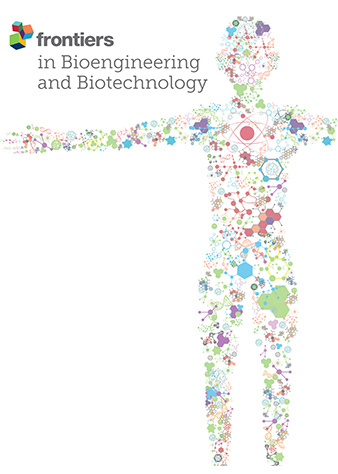Biofabrication of prevascularized spheroids for bone tissue engineering by fusion of microvascular fragments with osteoblasts
IF 4.3
3区 工程技术
Q1 BIOTECHNOLOGY & APPLIED MICROBIOLOGY
引用次数: 0
Abstract
IntroductionSpheroids are promising building blocks for scaffold-free bone tissue engineering. Their rapid vascularization is of major importance to guarantee their survival after transplantation. To achieve this, we herein introduce the biofabrication of prevascularized spheroids by fusion of adipose tissue-derived microvascular fragments (MVF) with osteoblasts (OB).MethodsFor this purpose, 200 MVF from donor mice and 5,000, 10,000 or 20,000 murine OB (MC3T3-E1) were co-cultured in a liquid overlay system for 3 days to generate OB + MVF spheroids. OB mono-culture spheroids served as controls.Results and discussionDuring the generation process, the diameters of all spheroids progressively decreased, resulting in compact, viable spheroids of homogeneous sizes. MVF promoted the maturation of spheroids containing 5,000 OB, as shown by an accelerated decline of cell proliferation due to contact inhibition. Moreover, MVF most effectively reassembled into new microvascular networks within these small spheroids when compared to the other spheroid types, indicating the most beneficial MVF to OB ratio. Accordingly, these spheroids also showed a high angiogenic sprouting activity通过微血管碎片与成骨细胞的融合,生物制造用于骨组织工程的前血管化球体
导言球状体是无支架骨组织工程中很有前景的构建模块。它们的快速血管化对保证其移植后的存活至关重要。为此,我们在此介绍了通过脂肪组织衍生的微血管片段(MVF)与成骨细胞(OB)的融合来生物制造预血管化球体的方法。为此,我们将 200 个来自供体小鼠的 MVF 和 5,000、10,000 或 20,000 个小鼠 OB(MC3T3-E1)在液体覆盖系统中共同培养 3 天,生成 OB + MVF 球体。结果与讨论在生成过程中,所有球体的直径逐渐减小,最终形成大小均匀、紧凑、有活力的球体。MVF 促进了含有 5,000 OB 的球体的成熟,具体表现为接触抑制导致细胞增殖加速下降。此外,与其他球体类型相比,MVF 在这些小球体内最有效地重新组装成了新的微血管网络,这表明 MVF 与 OB 的比例是最有益的。因此,这些小球在体外也表现出很高的血管新生发芽活性。与 OB 球体不同的是,这些球体移植到背侧皮褶室后在体内进一步快速血管化。这是由于结合的血管内皮细胞与周围血管相互连接造成的。这些研究结果表明,OB + MVF 球体可能适用于骨组织工程,下一步应在适当的体内骨缺损模型中进行测试。
本文章由计算机程序翻译,如有差异,请以英文原文为准。
求助全文
约1分钟内获得全文
求助全文
来源期刊

Frontiers in Bioengineering and Biotechnology
Chemical Engineering-Bioengineering
CiteScore
8.30
自引率
5.30%
发文量
2270
审稿时长
12 weeks
期刊介绍:
The translation of new discoveries in medicine to clinical routine has never been easy. During the second half of the last century, thanks to the progress in chemistry, biochemistry and pharmacology, we have seen the development and the application of a large number of drugs and devices aimed at the treatment of symptoms, blocking unwanted pathways and, in the case of infectious diseases, fighting the micro-organisms responsible. However, we are facing, today, a dramatic change in the therapeutic approach to pathologies and diseases. Indeed, the challenge of the present and the next decade is to fully restore the physiological status of the diseased organism and to completely regenerate tissue and organs when they are so seriously affected that treatments cannot be limited to the repression of symptoms or to the repair of damage. This is being made possible thanks to the major developments made in basic cell and molecular biology, including stem cell science, growth factor delivery, gene isolation and transfection, the advances in bioengineering and nanotechnology, including development of new biomaterials, biofabrication technologies and use of bioreactors, and the big improvements in diagnostic tools and imaging of cells, tissues and organs.
In today`s world, an enhancement of communication between multidisciplinary experts, together with the promotion of joint projects and close collaborations among scientists, engineers, industry people, regulatory agencies and physicians are absolute requirements for the success of any attempt to develop and clinically apply a new biological therapy or an innovative device involving the collective use of biomaterials, cells and/or bioactive molecules. “Frontiers in Bioengineering and Biotechnology” aspires to be a forum for all people involved in the process by bridging the gap too often existing between a discovery in the basic sciences and its clinical application.
 求助内容:
求助内容: 应助结果提醒方式:
应助结果提醒方式:


